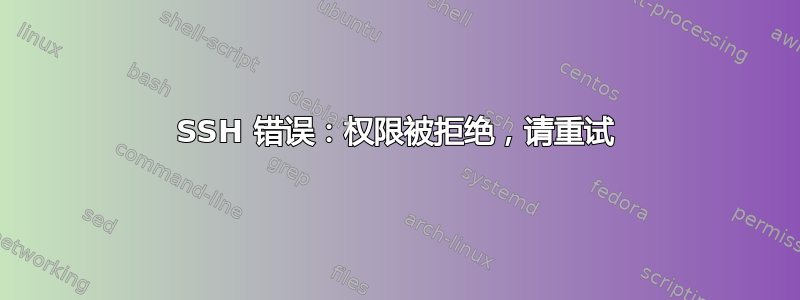
我有一个使用 amazon ec2 实例设置的 Ubuntu 服务器。我需要使用 SSH 将我的桌面(也是一台 ubuntu 机器)连接到 ubuntu 服务器。
我已经在 ubuntu 服务器上安装了 open-ssh。我需要网络中的所有系统都使用 SSH 连接 ubuntu 服务器(无需通过 pem 或 pub 密钥连接)。
因此在安全组(AWS)中为我的静态 IP 打开了 SSH 端口 22。
我的 SSHD-CONFIG 文件是:
# Package generated configuration file
# See the sshd_config(5) manpage for details
# What ports, IPs and protocols we listen for
Port 22
# Use these options to restrict which interfaces/protocols sshd will bind to
#ListenAddress ::
#ListenAddress 0.0.0.0
Protocol 2
# HostKeys for protocol version 2
HostKey /etc/ssh/ssh_host_rsa_key
HostKey /etc/ssh/ssh_host_dsa_key
HostKey /etc/ssh/ssh_host_ecdsa_key
#Privilege Separation is turned on for security
UsePrivilegeSeparation yes
# Lifetime and size of ephemeral version 1 server key
KeyRegenerationInterval 3600
ServerKeyBits 768
# Logging
SyslogFacility AUTH
LogLevel INFO
# Authentication:
LoginGraceTime 120
PermitRootLogin yes
StrictModes yes
RSAAuthentication yes
PubkeyAuthentication yes
#AuthorizedKeysFile %h/.ssh/authorized_keys
# Don't read the user's ~/.rhosts and ~/.shosts files
IgnoreRhosts yes
# For this to work you will also need host keys in /etc/ssh_known_hosts
RhostsRSAAuthentication no
# similar for protocol version 2
HostbasedAuthentication no
# Uncomment if you don't trust ~/.ssh/known_hosts for RhostsRSAAuthentication
#IgnoreUserKnownHosts yes
# To enable empty passwords, change to yes (NOT RECOMMENDED)
PermitEmptyPasswords no
# Change to yes to enable challenge-response passwords (beware issues with
# some PAM modules and threads)
ChallengeResponseAuthentication no
# Change to no to disable tunnelled clear text passwords
#PasswordAuthentication yes
# Kerberos options
#KerberosAuthentication no
#KerberosGetAFSToken no
#KerberosOrLocalPasswd yes
#KerberosTicketCleanup yes
# GSSAPI options
#GSSAPIAuthentication no
#GSSAPICleanupCredentials yes
X11Forwarding yes
X11DisplayOffset 10
PrintMotd no
PrintLastLog yes
TCPKeepAlive yes
#UseLogin no
#MaxStartups 10:30:60
#Banner /etc/issue.net
# Allow client to pass locale environment variables
AcceptEnv LANG LC_*
Subsystem sftp /usr/lib/openssh/sftp-server
# Set this to 'yes' to enable PAM authentication, account processing,
# and session processing. If this is enabled, PAM authentication will
# be allowed through the ChallengeResponseAuthentication and
# PasswordAuthentication. Depending on your PAM configuration,
# PAM authentication via ChallengeResponseAuthentication may bypass
# the setting of "PermitRootLogin without-password".
# If you just want the PAM account and session checks to run without
# PAM authentication, then enable this but set PasswordAuthentication
# and ChallengeResponseAuthentication to 'no'.
UsePAM yes
通过 webmin(命令 shell),我创建了一个名为“senthil”的新用户,并将该新用户添加到“sudo”组。
sudo adduser -y senthil
sudo adduser senthil sudo
我尝试使用这个新用户“senthil”在“webmin”中登录。我能够成功登录。
当我尝试通过 SSH 从我的终端连接 ubuntu 服务器时,
ssh senthil@SERVER_IP
它要求我输入密码。输入密码后,它显示:
Permission denied, please try again.
经过一番研究,我意识到我需要监控服务器的身份验证日志。我的身份验证日志 (/var/log/auth.log) 中出现了以下错误
Jul 2 09:38:07 ip-192-xx-xx-xxx sshd[3037]: pam_unix(sshd:auth): authentication failure; logname= uid=0 euid=0 tty=ssh ruser= rhost=MY_CLIENT_IP user=senthil
Jul 2 09:38:09 ip-192-xx-xx-xxx sshd[3037]: Failed password for senthil from MY_CLIENT_IP port 39116 ssh2
当我尝试使用以下方法进行调试时:
ssh -v senthil@SERVER_IP
OpenSSH_5.9p1 Debian-5ubuntu1, OpenSSL 1.0.1 14 Mar 2012
debug1: Reading configuration data /etc/ssh/ssh_config
debug1: /etc/ssh/ssh_config line 19: Applying options for *
debug1: Connecting to SERVER_IP [SERVER_IP] port 22.
debug1: Connection established.
debug1: identity file {MY-WORKSPACE}/.ssh/id_rsa type 1
debug1: Checking blacklist file /usr/share/ssh/blacklist.RSA-2048
debug1: Checking blacklist file /etc/ssh/blacklist.RSA-2048
debug1: identity file {MY-WORKSPACE}/.ssh/id_rsa-cert type -1
debug1: identity file {MY-WORKSPACE}/.ssh/id_dsa type -1
debug1: identity file {MY-WORKSPACE}/.ssh/id_dsa-cert type -1
debug1: identity file {MY-WORKSPACE}/.ssh/id_ecdsa type -1
debug1: identity file {MY-WORKSPACE}/.ssh/id_ecdsa-cert type -1
debug1: Remote protocol version 2.0, remote software version OpenSSH_5.8p1 Debian-7ubuntu1
debug1: match: OpenSSH_5.8p1 Debian-7ubuntu1 pat OpenSSH*
debug1: Enabling compatibility mode for protocol 2.0
debug1: Local version string SSH-2.0-OpenSSH_5.9p1 Debian-5ubuntu1
debug1: SSH2_MSG_KEXINIT sent
debug1: SSH2_MSG_KEXINIT received
debug1: kex: server->client aes128-ctr hmac-md5 none
debug1: kex: client->server aes128-ctr hmac-md5 none
debug1: sending SSH2_MSG_KEX_ECDH_INIT
debug1: expecting SSH2_MSG_KEX_ECDH_REPLY
debug1: Server host key: ECDSA {SERVER_HOST_KEY}
debug1: Host 'SERVER_IP' is known and matches the ECDSA host key.
debug1: Found key in {MY-WORKSPACE}/.ssh/known_hosts:1
debug1: ssh_ecdsa_verify: signature correct
debug1: SSH2_MSG_NEWKEYS sent
debug1: expecting SSH2_MSG_NEWKEYS
debug1: SSH2_MSG_NEWKEYS received
debug1: Roaming not allowed by server
debug1: SSH2_MSG_SERVICE_REQUEST sent
debug1: SSH2_MSG_SERVICE_ACCEPT received
debug1: Authentications that can continue: password
debug1: Next authentication method: password
senthil@SERVER_IP's password:
debug1: Authentications that can continue: password
Permission denied, please try again.
senthil@SERVER_IP's password:
对于密码,我输入了与“ubuntu”用户通常使用的相同的值。
有人可以告诉我问题出在哪里并为这个问题提出一些解决方案吗?
答案1
您已锁定帐户。
来自的手册页usermod(8):
-L, --lock
Lock a user's password. This puts a '!' in front of the encrypted password,
effectively disabling the password.
现在看看你的shadow台词:
ubuntu:!$6$rWDSG...HSi1:15347:0:99999:7:::
解锁:
usermod -U ubuntu
重要提示!如果此用户已预安装在系统上,则可能会出于某种原因(安全原因)被锁定,但我无法为您决定,因为这显然不是常规的 Ubuntu 安装。
如果以上内容让您感到不舒服,您可以创建一个单独的用户:
sudo adduser username
并回答问题。您应该能够正常登录。还可以sudo通过将其添加到组来使其能够成为 root(使用)sudo:
sudo adduser username sudo
如果您需要ubuntu在命令行上切换到用户,则必须使用提升的权限,因为您无法提供凭据,原因与您无法使用 SSH 登录的原因相同。现在,使用 SSH 以 身份登录username,然后运行此命令以变为ubuntu:
sudo su -l ubuntu
出于安全原因,我不建议root直接使用登录。
答案2
这不是该问题的确切答案。但就我而言,存在冗余行。(相同的行出现了两次)
PermitRootLogin yes
并且
AllowUsers otheruser
您应该将“root”用户添加到此行或注释此行。
并重启sshservice sshd restart
答案3
我遇到了同样的问题并且花费了我很多时间。
然而,我注意到这是一个密码错误由于服务器和客户端的键盘布局不同:
在服务器中,我认为我设置了密码:WEwd@ds
并且,我注意到它@是"在服务器键盘布局中。
因此正确的密码是:WEwd"ds
因此,您需要检查:
服务器键盘布局与工作站键盘布局
答案4
我找到了问题所在并解决了。
我创建了一个新用户(名为:senthil),并刚刚将其用于 SSH。在 Ubuntu 中,我觉得当我们创建新用户时,默认情况下会将 root 用户的密码分配给新用户。即使这样,也要重置并为新创建的用户分配一些新密码。
重置用户密码并在 sshd_config 中做出以下更改后,我现在可以将我的所有系统(从我的网络)连接到远程服务器。
请注意:我已经关闭了所有 SSH 身份验证(如 RSAAuthentication、PubkeyAuthentication 和 KerberosAuthentication)。我只打开了 PasswordAuthentication。
谢谢。


